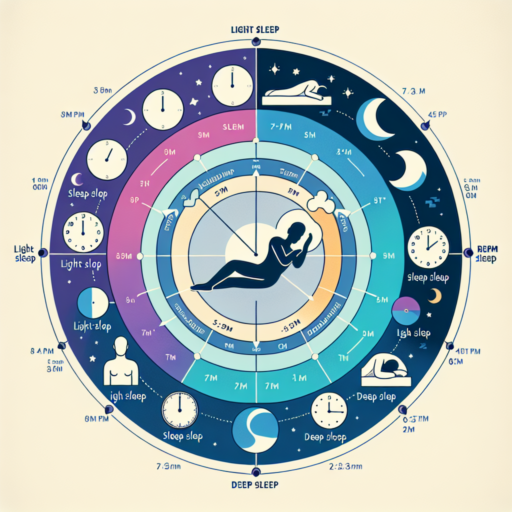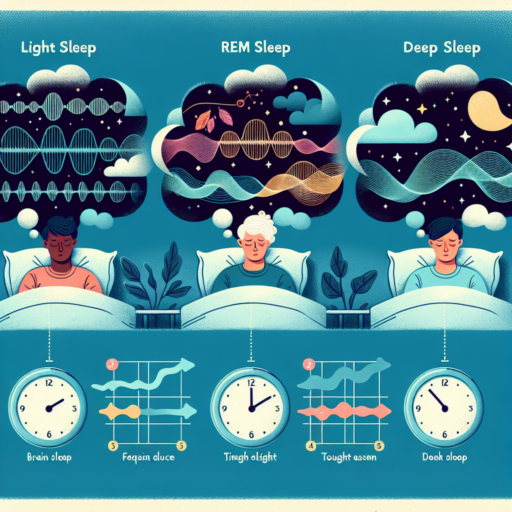What is a normal sleep cycle?
Understanding the normal sleep cycle is crucial because it impacts our daily functioning, health, and mood. Typically, a normal sleep cycle consists of four to six cycles each night, with each cycle lasting about 90 to 110 minutes. These cycles are composed of four stages: three stages of non-REM (NREM) sleep and one stage of REM (Rapid Eye Movement) sleep.
During the first half of the night, our bodies spend more time in the deep NREM stages 3, which is essential for physical recovery and growth. As the night progresses, the duration of REM stages increases, which is crucial for cognitive functions such as memory consolidation, learning, and emotional regulation.
Understanding these cycles helps in identifying sleep disorders and in improving sleep health. It is important to maintain consistent sleep patterns to support the natural rhythm of these cycles, which in turn, facilitates better sleep quality and overall health.
What percentage of sleep should be in each cycle?
Understanding the percentage of sleep that should be in each cycle is crucial for optimizing rest and enhancing overall well-being. The human sleep cycle consists of various stages, each playing a vital role in health and recovery. While individual needs may vary, there are general benchmarks that can help guide us toward a more restorative sleep pattern.
The sleep cycle is divided into two main types: Non-REM (Rapid Eye Movement) and REM sleep. Non-REM sleep itself includes three stages, making up approximately 75-80% of total sleep time. The first stage of Non-REM, known as N1, is the lightest sleep phase and typically constitutes 5% of the cycle. Following this, N2, a slightly deeper sleep stage, accounts for about 45-55% of sleep. The third stage, N3, often referred to as deep sleep or slow-wave sleep, makes up 15-25% of the overall cycle.
On the other hand, REM sleep, the stage associated with vivid dreams, takes up about 20-25% of the night for adults. It’s essential for cognitive functions such as memory, learning, and creativity. Achieving a balanced distribution across these stages can significantly influence one’s physical health, mood, and mental sharpness.
No se han encontrado productos.
How long should you be in each stage of sleep?
The duration each individual spends in the various stages of sleep can greatly influence overall health and cognitive function. Understanding the ideal length of time for each stage can provide insights into improving sleep quality.
NREM (Non-Rapid Eye Movement) Sleep Stages
The NREM phase consists of three stages, each serving a unique role in the sleep cycle. The first stage, which acts as the transition from wakefulness to sleep, should last approximately 1 to 5 minutes. The second stage is where we spend the majority of our sleep, roughly 45-55% of total sleep time, emphasizing its importance in physical restoration and memory consolidation. Finally, the third stage, known as deep sleep, is vital for physical health and recovery, ideally making up 13-23% of a typical night’s sleep.
REM (Rapid Eye Movement) Sleep Stage
The REM stage, occurring after the NREM stages, is where most dreaming happens. It is crucial for emotional regulation and memory processing. Ideally, adults should aim to spend about 20-25% of their sleep in this stage. It is worth noting that the length of REM periods increases as the night progresses, with the longest periods occurring just before waking.
While these percentages provide a guideline, it’s essential to remember that individual needs may vary. Factors such as age, lifestyle, and health can influence the optimal sleep stage durations for any given person.
How much REM sleep is normal?
Understanding the amount of REM (Rapid Eye Movement) sleep that is considered normal plays a crucial role in assessing the quality of your sleep and overall health. REM sleep, characterized by rapid eye movements, vivid dreams, and increased brain activity, forms an essential part of the sleep cycle. Typically, adults experience REM sleep approximately 20 to 25% of their total sleep time, translating to around 90 to 120 minutes of REM sleep per night.
Several factors can influence the amount of REM sleep you get, including age, lifestyle, and overall health. For instance, newborns spend about 50% of their sleep time in REM, highlighting the importance of this sleep stage for brain development. As we age, however, the percentage of REM sleep decreases. This change emphasizes the need to monitor and adjust habits to ensure optimal REM sleep duration as part of a healthy sleep pattern.
Maintaining a normal range of REM sleep is vital for memory consolidation, cognitive function, and emotional regulation. Disruptions in REM sleep, whether due to sleep disorders such as sleep apnea or lifestyle factors like alcohol consumption before bedtime, can significantly impact your health. Recognizing the signs of insufficient REM sleep, such as fatigue, mood swings, or difficulty concentrating, is key to addressing any potential issues early on.




